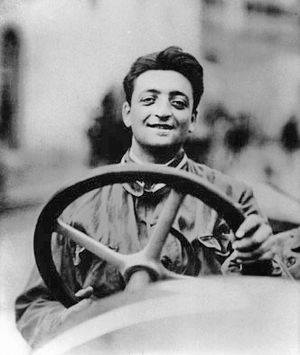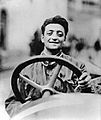Enzo Ferrari facts for kids
Enzo Anselmo Giuseppe Maria Ferrari (born February 20, 1898 – died August 14, 1988) was an Italian race car driver and businessman. He was the person who started the famous Scuderia Ferrari racing team and later the Ferrari car company. People often called him "il Commendatore" (the Commander) or "il Drake." In his later years, he was known as "l'Ingegnere" (the Engineer) or "il Grande Vecchio" (the Great Old Man).
Quick facts for kids
Enzo Ferrari
|
|
|---|---|
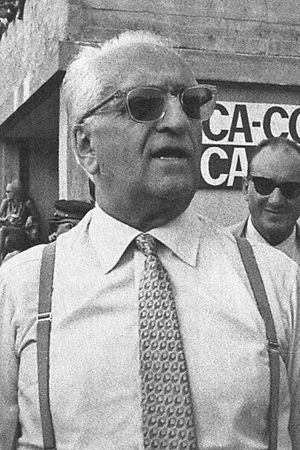
Ferrari in 1967
|
|
| Born |
Enzo Anselmo Giuseppe Maria Ferrari
20 February 1898 |
| Died | 14 August 1988 (aged 90) Maranello, Italy
|
| Nationality | Italian |
| Occupation | Racecar driver, Professional motor racing team entrepreneur, Automotive industry executive and industrialist |
| Known for | Founding Ferrari and Scuderia Ferrari |
| Spouse(s) |
Laura Dominica Garello
(m. 1923; died 1978) |
| Partner(s) | Lina Lardi |
| Children | Alfredo Ferrari Piero Ferrari |
Contents
Early Life and Dreams
Enzo Ferrari was born in Modena, Italy, on February 20, 1898. His father owned a workshop that made metal parts. Enzo didn't have much formal schooling.
When he was 10, he watched a car race and was so inspired that he decided he wanted to become a racing driver. During World War I, he served in the Italian Army. Sadly, his father and older brother passed away in 1916. Enzo himself became very ill but recovered.
Starting a Racing Career
After his family's business closed, Enzo looked for a job in the car world. He started as a test driver for a company in Milan. Soon, he became a race car driver.
His first race was in 1919. In 1920, he joined Alfa Romeo as a driver. He won his first Grand Prix race in 1923. His best year was 1924, with three wins.
Enzo was deeply affected by the deaths of fellow drivers. After his son Alfredo (Dino) was born in 1932, Enzo decided to stop driving. He wanted to focus on managing and developing race cars instead.
The Prancing Horse Emblem
Enzo founded his own racing team in 1929, called Scuderia Ferrari. This team worked as the racing division for Alfa Romeo.
The famous "prancing horse" emblem started appearing on his team's cars. This symbol was originally used by an Italian fighter pilot named Francesco Baracca. Baracca's mother gave Enzo a necklace with the prancing horse on it. After Baracca was killed in World War I, Enzo used the prancing horse to create the famous Ferrari shield. It first appeared on a Ferrari car in 1947.
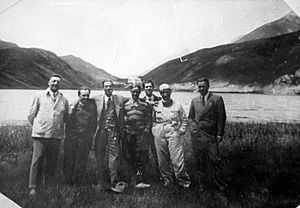
Building the Ferrari Company
Alfa Romeo supported Enzo's racing team until 1933. Even with great drivers, the team struggled against powerful German cars. However, in 1935, Enzo's team won a big race in Germany.
In 1937, Scuderia Ferrari was closed, and Enzo returned to Alfa Romeo's own racing team. He later left Alfa Romeo in 1939 and started his own company, Auto-Avio Costruzioni. This company made parts for other racing teams.
During World War II, Enzo's factory had to make things for the government. After the war, Enzo decided to build cars under his own name. He founded Ferrari S.p.A. in 1947.
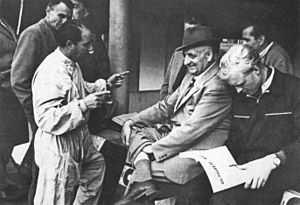
Enzo wanted his own team to compete against the dominant Alfa Romeos. Ferrari's first big win was at the 1949 24 Hours of Le Mans race. In 1950, Ferrari joined the new Drivers World Championship (now Formula One). Ferrari is the only team to have been in every season since then.
Ferrari won its first Grand Prix in 1951. The team won its first championship in 1952 and again in 1953. To help pay for his racing, Enzo started selling sports cars to the public.
Challenges and Changes
Ferrari's decision to keep racing in the Mille Miglia brought the company many wins. However, this race became very dangerous due to high speeds and lack of safety for spectators. Sadly, a serious accident happened in 1957, which led to the race being stopped.
Ferrari had a strong personality. In 1962, some key people left the company due to disagreements. However, Enzo brought in new, talented engineers and drivers. This shake-up helped Ferrari become even stronger. The team won the world title in 1964 with driver John Surtees.
Partnering with Fiat
By the late 1960s, Ferrari faced financial challenges. To help the company grow and meet new rules for road cars, Enzo looked for a partner. In 1969, he sold 50% of his company to Fiat S.p.A.. Enzo made sure he would still have full control over the racing team.
After the agreement with Fiat, Enzo stepped down from managing the road car division in 1971. He appointed Luca Cordero di Montezemolo to manage the Formula One team. Ferrari continued to win championships in the 1970s.
The Fiorano Circuit
In the early 1970s, Enzo Ferrari wanted to improve the race track in Modena. When this didn't happen, he bought land next to his factory. He built the Fiorano Circuit, a 3 km track that is still used today to test Ferrari racing and road cars.
Later Years and Legacy
After winning a championship in 1979, the team had a tough year in 1980. Enzo tried to improve the team by using turbo engines. In 1982, the new turbo-powered Ferrari cars showed great promise. However, two of his drivers, Gilles Villeneuve and Didier Pironi, were involved in serious accidents that year. Despite these challenges, the team won the Constructors' Championship in 1982 and 1983.
Enzo Ferrari lived a private life. He rarely gave interviews and seldom left Modena or Maranello. He never flew in an airplane.
He married Laura Domenica Garello in 1923. They had one son, Alfredo "Dino," who passed away in 1956. Enzo also had another son, Piero Ferrari, born in 1945. Piero is now the vice chairman of the Ferrari company.
Enzo Ferrari passed away on August 14, 1988, at the age of 90. His death was announced two days later, as he requested. The Ferrari F40 car was launched shortly before he died, as a symbol of his achievements. In 2002, Ferrari started making the Ferrari Enzo car, named after its founder.
Just weeks after Enzo's death, Ferrari cars finished first and second at the 1988 Italian Grand Prix. Since his passing, the Scuderia Ferrari team has continued to be very successful, winning many championships.
Images for kids
-
Drivers Enzo Ferrari (first from left), Tazio Nuvolari (fourth), and Achille Varzi (sixth) of Alfa Romeo, around 1933.
-
Alberto Ascari (left), Enzo Ferrari (center), and Mike Hawthorn (right) at the Monza Circuit in 1953.
See also
 In Spanish: Enzo Ferrari para niños
In Spanish: Enzo Ferrari para niños
- Ferrari (film)
- The Snake and the Stallion


